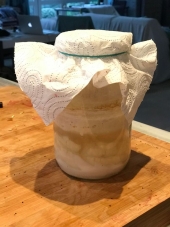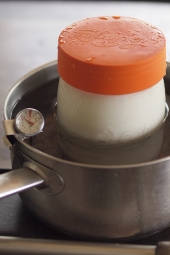
 2
2




Sourdough Without Fail Natural Small Batch Cheesemaking A Year in an Off-Grid Kitchen Backyard Dairy Goats My website @NourishingPermaculture @KateDownham






 3
3




 3
3




 3
3




 4
4




“All good things are wild, and free.” Henry David Thoreau
 2
2




The wishbone never could replace the backbone.
 2
2




 2
2





 5
5




Kate Downham wrote:I’m having trouble finding information about listeria other than anti-raw-milk sources.
A big fuss is made about listeria during pregnancy, with a long list of foods to avoid eating, which include very nourishing ones that were everyday foods for my ancestors. I am wondering whether the reason these foods are considered risky today is because of the unnatural way many animals are raised today? And if the reason our ancestors could eat these foods and have babies was because they were much healthier and resilient from a nourishing diet with lots of good bacteria?
Nearly everyone I know seems to get food poisoning every so often. I think the statistic in Australia is that one in five people get food poisoning every year. I eat foods every day that a lot of people consider to be dangerous, but I've never had food poisoning from any of them.
Is it possible, that in someone that eats so much good bacteria every day from raw milk, yoghurt, kefir, kimchi, kombucha etc, that there is no niche in their body for bad bacteria to take over?
Does this good bacteria make it impossible for someone eating a diet like that to get listeria?
Is it only factory farmed animal foods that are causing the food poisoning?
Is the medical establishment just finding new ways to say mean things about raw milk whenever they get a chance? Or is there actually a risk that drinking fresh milk from my own animals will cause listeria?
What foods are actually risky? Is homemade raw yoghurt a risk? Are kefir and soured milk riskier than fresh milk? Is avoiding soft cheese and raw charcuterie during pregnancy enough to avoid listeria?
It is a privilege to live, work and play in the traditional territory of the Salish People.
Now drop and give me 52... ~ Come Join the permies Shoecamp! ~ All about Permies, including Tutorials ---
Twenty bucks off the homesteading bundle for the next 72 hours!
 6
6




Sourdough Without Fail Natural Small Batch Cheesemaking A Year in an Off-Grid Kitchen Backyard Dairy Goats My website @NourishingPermaculture @KateDownham






 5
5




Sonja Draven wrote:Lots of kids in my family and we grew up drinking raw cow and goats milk, along with whole wheat and the diet you are describing. None of us died.
But we got sick with severe colds, bronchitis, the flu, random digestive issues and other painful sickness regularly. I don't know what all we had because we weren't doctor people.
Now, many of us have serious / chronic health issues that started then and have been positively impacted by switching to a plant based whole foods diet. For me, the lesser illnesses like colds and the flu have basically disappeared too.
I do see food as medicine. But in my experience, it's not the food described in the original post.
Sourdough Without Fail Natural Small Batch Cheesemaking A Year in an Off-Grid Kitchen Backyard Dairy Goats My website @NourishingPermaculture @KateDownham






 2
2




Sourdough Without Fail Natural Small Batch Cheesemaking A Year in an Off-Grid Kitchen Backyard Dairy Goats My website @NourishingPermaculture @KateDownham






 3
3




The temperature range for growth of L. monocytogenes is between -1.5 and 45°C, with the
optimal temperature being 30–37°C. Temperatures above 50°C are lethal to L.
monocytogenes. Freezing can also lead to a reduction in L. monocytogenes numbers (Lado
and Yousef 2007). As L. monocytogenes can grow at temperatures as low as 0°C, it has the
potential to grow, albeit slowly, in food during refrigerated storage.
Occurrence in food
L. monocytogenes has been isolated from various ready-to-eat products. In a study by
Meldrum et al. (2010) the prevalence of L. monocytogenes was
4.1% in crustaceans(n=147),
6.7% in smoked fish (n=178),
2% in sushi (n=50) and
0.9% in green salad (n=335)samples in Wales. Wong et al. (2005) isolated L. monocytogenes from
1% of ham (n=104)and
1.7% of pate (n=60) samples in New Zealand.
L. monocytogenes has also been isolated from dairy products. For example, L. monocytogenes was detected in
1.3% of fresh cheese 5 samples in Spain (n=78),
0.2% of hard cheese samples in the United Kingdom (n=1242) and
0.3% of ice creams in Italy (n=1734) (Busani et al. 2005; Cabedo et al. 2008; Little et al. 2009).
The prevalence of L. monocytogenes in bulk milk tank internationally is 1–60% (FSANZ 2009).
The presence of L. monocytogenes in ready-to-eat products is probably due to
contamination occurring after the product has been processed. This contamination may
occur during additional handling steps such as peeling, slicing and repackaging. Also, in the
retail and food service environment, contamination may be transferred between ready-to-eat
products (Lianou and Sofos 2007). The type of handling that ready-to-eat meat receives may
also influence the level of L. monocytogenes contamination. In a survey of retail packaged
meats there was a significantly higher prevalence of L. monocytogenes reported in products
cut into cubes (61.5%) (n=13), compared with sliced products (4.6%) (n=196) (Angelidis and
Koutsoumanis 2006).
Investigations of foodborne outbreaks of non-invasive listeriosis have concluded that
consumption of food with high levels of L. monocytogenes (1.9 x 105
/g to 1.2 x 109/g) is required to cause illness in the general healthy population (Sim et al. 2002).
The number of L. monocytogenes required to cause invasive listeriosis depends on a
number of factors. These include the virulence of the particular serotype of
L. monocytogenes, the general health and immune status of the host, and attributes of the
food (for example fatty foods can protect bacteria from stomach acid).
People at risk of invasive listeriosis include pregnant women and their foetuses, newborn
babies, the elderly and immunocompromised individuals (such as cancer, transplant and
HIV/AIDS patients). Less frequently reported, but also at a greater risk, are patients with
diabetes, asthma, cirrhosis (liver disease) and ulcerative colitis (inflammatory bowel disease)
(FDA 2012).




 1
1




Iterations are fine, we don't have to be perfect
My 2nd Location:Florida HardinessZone:10 AHS:10 GDD:8500 Rainfall:2in/mth winter, 8in/mth summer, Soil:Sand pH8 Flat
 1
1




Sourdough Without Fail Natural Small Batch Cheesemaking A Year in an Off-Grid Kitchen Backyard Dairy Goats My website @NourishingPermaculture @KateDownham






 2
2




Kate Downham wrote:Thank you Amy! That is really helpful.
Maybe I searched in the wrong way, or Startpage search results in Australia had put SEO-optimised but generally unhelpful websites at the top or something else that led to me seeing virtually identical unhelpful lists of foods to avoid.
I drank raw milk from my own goats all through two pregnancies and was fine. After reading what you've written, it confirms my thoughts about bacteria growing, and I think a safe strategy for pregnancy would be to drink the milk when it's very fresh. I am still not sure what to do about kefir and raw yoghurt though.
In conclusion, Kefir microflora found to be suppressive on L. monocytogenes serotypes studied in this study. Besides, there was significant survival difference between all L. monocytogenes serotypes. The major reduction in the study was 2.37 log cfu/ml which was detected in the second hour of 104 cfu/ml contaminated kefir experiment with 4b serotype. Therefore, we can conclude from this study that despite the high acidity of kefir, it could be potentially hazardous to the public health if it is contaminated with the pathogens studied here in. Such risk would increase if the product was contaminated before the fermentation period.
the growth of L. monocytogenes was only inhibited by kefir M fermented for 24 h, suggesting kefir M could contain a microorganism which produces an anti-L. monocytogenes molecule (i.e., bacteriocins). These data suggested that the antimicrobial activity of kefirs could be attributable to specific antimicrobial substances and not simply due to low pH values
 1
1




INFECTIVE DOSE – How many bacteria are needed to cause an infection? The quantity of bacteria on food is expressed as the number of colony-forming units per gram (CFU/g). Levels of 100 CFU/g in food at point of consumption are regarded as safe, meaning that people consuming foods with low levels of L. monocytogenes have an extremely low risk of contracting listeriosis. As with all disease-causing micro-organisms there is no threshold below which there is a true “zero” risk for human illness. Estimates based on US data suggest though that less than 0.2% of the 2,500 listeriosis cases that occur annually in the US are caused by foods contaminated with 100 or less CFU per serving. By contrast, more than 80% of these cases are caused by foods contaminated with more than one million CFU per serving. Thus foods that contain extremely high levels of L. monocytogenes represent the main risk for consumers.
The occurrence of L. monocytogenes was higher (4.8%) in bottled raw milk stored until the use-by-date of the package compared to fresh bulk tank milk (1.7%). L. monocytogenes counts were ≤13CFU/ml in bottled raw milk and ≤1CFU/ml in bulk tank milk.
Targeted inoculum levels of 1-2CFU/ml yielded L. monocytogenes counts≥100CFU/ml within seven days of storage in 22% of the raw milk packages stored at 6°C, and in all of the raw milk packages stored at 8°C.
Sourdough Without Fail Natural Small Batch Cheesemaking A Year in an Off-Grid Kitchen Backyard Dairy Goats My website @NourishingPermaculture @KateDownham






 1
1




![Filename: 50754150_839497089727546_8827060200268627968_n.jpg
Description: [Thumbnail for 50754150_839497089727546_8827060200268627968_n.jpg]](/t/132606/a/99391/50754150_839497089727546_8827060200268627968_n.jpg)
Sourdough Without Fail Natural Small Batch Cheesemaking A Year in an Off-Grid Kitchen Backyard Dairy Goats My website @NourishingPermaculture @KateDownham






 1
1




Kate Downham wrote:
Many people on a vegan diet are initially very enthusiastic, but get burnt out in a decade or less.
Still able to dream.

 1
1




If there is one thing the Wizard of Oz has taught me, it is not to trust school teachers on bicycles.




 4
4




Sourdough Without Fail Natural Small Batch Cheesemaking A Year in an Off-Grid Kitchen Backyard Dairy Goats My website @NourishingPermaculture @KateDownham







|
All that thinking. Doesn't it hurt? What do you think about this tiny ad?
The new kickstarter is now live!
https://www.kickstarter.com/projects/paulwheaton/garden-cards
|



